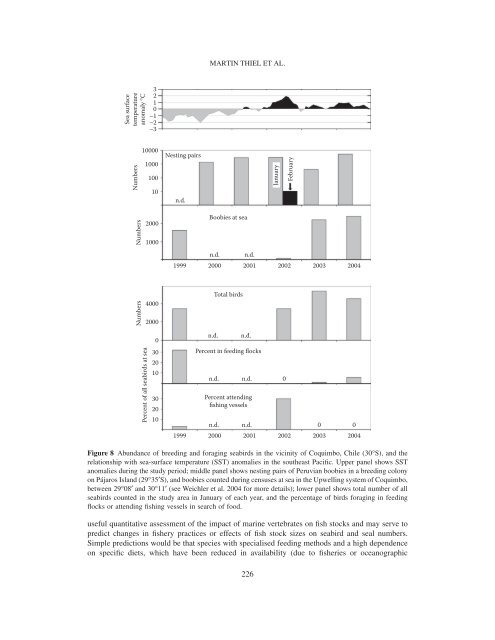the humboldt current system of northern and central chile - figema
the humboldt current system of northern and central chile - figema
the humboldt current system of northern and central chile - figema
You also want an ePaper? Increase the reach of your titles
YUMPU automatically turns print PDFs into web optimized ePapers that Google loves.
MARTIN THIEL ET AL.Sea surfacetemperatureanomaly °C3210−1−2−3Numbers10000100010010Nesting pairsn.d.JanuaryFebruaryNumbers20001000Boobies at sean.d. n.d.1999 2000 2001 2002 2003 2004Numbers40002000Total birdsPercent <strong>of</strong> all seabirds at sea0302010302010n.d.n.d.Percent in feeding flocksn.d.n.d.Percent attendingfishing vesselsn.d. n.d. 0 01999 2000 2001 2002 2003 20040Figure 8 Abundance <strong>of</strong> breeding <strong>and</strong> foraging seabirds in <strong>the</strong> vicinity <strong>of</strong> Coquimbo, Chile (30°S), <strong>and</strong> <strong>the</strong>relationship with sea-surface temperature (SST) anomalies in <strong>the</strong> sou<strong>the</strong>ast Pacific. Upper panel shows SSTanomalies during <strong>the</strong> study period; middle panel shows nesting pairs <strong>of</strong> Peruvian boobies in a breeding colonyon Pájaros Isl<strong>and</strong> (29°35′S), <strong>and</strong> boobies counted during censuses at sea in <strong>the</strong> Upwelling <strong>system</strong> <strong>of</strong> Coquimbo,between 29°08′ <strong>and</strong> 30°11′ (see Weichler et al. 2004 for more details); lower panel shows total number <strong>of</strong> allseabirds counted in <strong>the</strong> study area in January <strong>of</strong> each year, <strong>and</strong> <strong>the</strong> percentage <strong>of</strong> birds foraging in feedingflocks or attending fishing vessels in search <strong>of</strong> food.useful quantitative assessment <strong>of</strong> <strong>the</strong> impact <strong>of</strong> marine vertebrates on fish stocks <strong>and</strong> may serve topredict changes in fishery practices or effects <strong>of</strong> fish stock sizes on seabird <strong>and</strong> seal numbers.Simple predictions would be that species with specialised feeding methods <strong>and</strong> a high dependenceon specific diets, which have been reduced in availability (due to fisheries or oceanographic226










